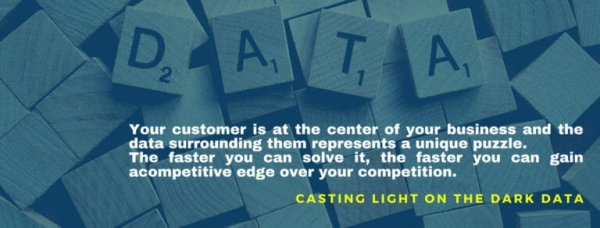Casting Light On Dark Data

Dark data sounds ominous and mysterious, but don’t worry. Although it sounds like something sinister, this type of data is no danger to your business.
It is actually the opposite – dark data can unlock a new world of hidden opportunities for your business.
Maybe the right information for your business is lurking in the dark, looking for the light of opportunity. This is not to say that sifting through this information is always easy. The process of finding hidden treasures in the dark can be very overwhelming and, without the right tools, sometimes very costly.
Today, we are casting light on the world of dark data, bringing in a kind of digital renaissance with the helping hand of cognitive automation. Unstructured data has amazing potential to streamline your processes, reduce cost, and make a bridge between sometimes completely unrelated information.
How can dark data help with better decision making, discovering patterns, and faster acclimation to changes? Are you ready to take that step in the dark?
WHAT IS DARK DATA?
And what exactly makes data dark?
According to Gartner, dark data represents information assets that businesses collect and store during business processes but fail to meet their purpose and be used properly (monetizing, analytics, business processes, etc). To define it in simple words – it represents the information that isn’t well-defined, indexed, or easily searchable.

Dark data is often saved for compliance purposes, yet it hides the amazing potential
WHAT PERCENTAGE OF DATA COLLECTION IS CONSIDERED DARK?
Now let’s dive into some interesting dark data statistics to cast some light on the current state of things.
- Believe it or not, 80% of data is considered dark. It is estimated that this number will grow even more, up to 93% percent. This is because interconnected devices are constantly generating data.
- Why does dark data remain dark? Approximately 39% percent of companies are not equipped with adequate skills or resources or they are simply overwhelmed by the volume of constantly generated data.
- Because there is so much unstructured data being generated, 71% of executives are convinced that the value of the dark data will increase in the next ten years.
Source: Datumize
When we see things in this light we can conclude that forward-thinking business owners are well aware of hidden gems lurking in the dark. Most of them simply don’t have the resources to offset the risk or don’t have the necessary data-centric skillset to investigate unstructured data themselves.
ARE DARK DATA AND UNSTRUCTURED DATA THE SAME THING?
Unstructured data and dark data are often mentioned hand in hand and they mostly refer to the same thing. Unstructured data is data waiting to be refined and to be put to good use. Giving this kind of data structure and purpose can be a big challenge for engineers.
WHAT IS AN EXAMPLE OF UNSTRUCTURED?
Some dark data examples include log files, financial statements, customer call records, surveillance video footage, business emails, data about former employees, even notes, old documents, presentations and so much more.
HOW CAN THE PROPER USE OF THIS DATA HELP YOUR BUSINESS?
If you analyze dark data you will get valuable insights about your customers’ likes and dislikes and will help you understand the customer’s journey much better.
In the post-Covid-19 era when we are still getting used to the new normal, eCommerce is on the rise. So in this era, personalization will play a major role. After all, no one likes to be treated as a statistic or referred to as “just a customer.”
Your customer is at the center of your business and the data surrounding them represents a unique puzzle and the faster you can solve it, the faster you can gain a competitive edge over your competition.
Acting in real-time is one of the crucial elements for harnessing dark data. If you store all the data it may lose its value as time passes.
HOW COGNITIVE PROCESS AUTOMATION CAN CAST LIGHT ON DARK DATA
There are so many buzzwords floating around in the ether nowadays such as machine learning, robotic process automation (RPA), artificial intelligence (AI), and cognitive automation. Although these sound similar, they are not. Each of them represents an important part of the transformation happening right before our eyes.
Cognitive robotic process automation is the extension of robotic process automation. Cognitive automation mimics human behavior and it is made for more complex operations such as analytics, recommending further actions, and judgment.
Contrary to RPA that works with structured and semi-structured data, cognitive automation works with unstructured data also.
Some areas of your business that can benefit from utilizing cognitive automation and putting dark data to use:
- Accounting: Invoices, orders, and purchase contracts are semi-structured data. Accounts payable can make the invoicing process more automated and cognitive automation can take a human role of opening emails, extracting the important data from invoices, emails, and documents. Dark data research is done in real-time, which prevents data from getting stale or forgotten.
- Customer journey made easier: Cognitive automation can make the customer journey easier in terms of security, analytics, and providing necessary assistance based on customer data.
- Retail: Cognitive automation can help with harmonizing data from different vendors in real-time, and it can help with proper product categorization. There are so many different formats when it comes to products — text, images, files, and more. Cognitive automation can harmonize all these elements and avoid costly errors.
- Document management and processing: Managing paperwork manually is behind us. Cognitive automation uses optical character recognition technology to scan different document types. This is important for industries like healthcare because many different documents and forms are used and each is important to ensure proper care for each patient.
- HR and employee onboarding process: Onboarding is a very time-consuming process. But thanks to cognitive automation, it can be efficient thanks to bots that, for example, can create logins for new employees.
By utilizing cognitive automation you improve the efficiency of your regular business activities by using large amounts of data that went under your radar for a long time.
Cognitive automation added to a human behavior component can lead to costs that are reduced by as much as 50%. (Source: Expert System)
DARK DATA BROUGHT TO LIGHT
Now when we put dark data in the spotlight, along with cognitive automation, are you getting some ideas on how to utilize this valuable, often misunderstood asset? Unstructured data and data analytics shouldn’t be complicated when we have such amazing technologies emerging.
Cognitive automation can improve your day-to-day activities. Bots that are learning from human behavior will bring structure to dark data and give it a purpose.